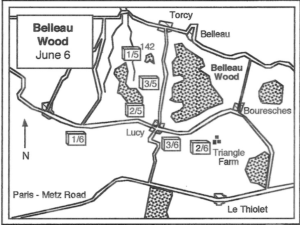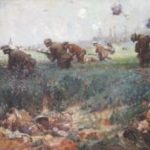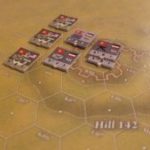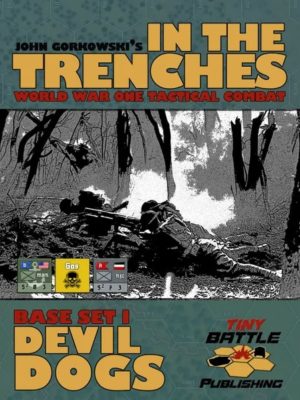Physical Address
304 North Cardinal St.
Dorchester Center, MA 02124
Physical Address
304 North Cardinal St.
Dorchester Center, MA 02124

The famous quote at the top, by Capt. Lloyd Williams, USMC was uttered during the Battle of Belleau Wood where the 5th Marine Regiment, attached to the U.S. Army’s 2nd Division, itself part of the American Expeditionary Force, took on the Kaiser’s Army in the immediate aftermath of the Germans’ 1918 Spring Offensive. The efforts of the 5th and 6th Marine Regiments (collectively the 4th Marine Brigade) in the area of Belleau Wood would add another chapter to the growing legend of the United States Marine Corps.
As the debut game in Tiny Battle Publishing’s version of John Gorkowski’s In the Trenches series (previously published by Grenier Games), In the Trenches: Devil Dogs covers the Marines’ efforts against the Kaiser’s crack troops in those battles during June of 1918, fights that caused the Germans to give the Marines the moniker “Teufelhunden” which translates to, you guessed it: Devil Dogs.
Designer John Gorkowski has (according to BoardGameGeek) a couple dozen titles under his belt. And a large percentage of those are World War I games. Making a tactical game of “The Great War” is a big challenge since that particular war is famous (or infamous) for the static nature of the fighting on the Western Front. That view isn’t entirely true (the Eastern Front was more fluid and there were certainly periods when the Western Front saw significant territorial gains by both sides), but many wargamers might scoff at a “tactical” World War I game based on the idea that “it was a trench-based slog” of a war.
Gorkowski has two tactical-level series set in the First World War: “Red Poppies Campaigns” and “In The Trenches.” The former is a newer series, grander in size and production-value and generally focusing on one battle or campaign. But “In the Trenches” came first, with a trio of titles published originally by now-defunct Grenier Games in 2009-10. Those games, reworked by Gorkowski and the Tiny Battle team headed by Mark H. Walker have now been re-released and expanded upon in a series that began with “Devil Dogs” and has thus far continued through six additional games, the most recent of which was released in 2017.



WHAT’S IN THE BAG?
The game features a 20-page rule book, three maps on 2 pieces of 8.5″ x 11″ paper (one is double-sided) set in and around Belleau Wood. One map features Hill 142, the other the area around the town of Lucy and the third a thoroughly shelled and cratered area. You also get 2 half-sheets of counters, many of them markers that aren’t particularly needed until you get some of the expansions to this base game, but also 16 platoons of Marines as well as one company of Germans plus some supporting units (mortars, machine guns, etc.). There’s also a player’s aid sheet with the three operations (scenarios) on the back and a turn track.
MECHANICS
So how’s it work?
Well, it’s actually pretty straightforward. Those 20 pages of rules have several examples that help explain the mechanics. Some highlights include:
What’s not included, and something you’ll need, are dice. I used four of different colors, two per side so that both had “their own” dice. Two dice are what you’ll need as you don’t necessarily need to roll simultaneously in two-player games.
I really enjoyed this game – as I suspected I would. I do like a good tactical game and this one certainly fits the bill. I was also interested in playing the USMC’s famous fights in Belleau Wood. Though this is not the case in the Hill 142 operation the game includes a “shock troop” mechanic that is applied to the Marines in the other operations. This makes them more flexible and powerful and is another clever mechanic for simulating the “elite” nature of the Marines and also, I am guessing, for the “Strosstruppen” of the Germans in some of the expansions.
My only real complaint – and it’s certainly not a deal-breaker – is that I had a really difficult time getting the counters out of their frames. This is a low-cost game and obviously you’re not going to get the top-notch components of something like Old School Tactical (published by Tiny Battle’s sibling Flying Pig Games). But it was still a bummer to have to fight to get the counters out and some of them took a little cosmetic damage along the way. I have big hands and nimble fingers are not something I possess. As I said, not a big deal, but some would find the need to clip some of the “tabs” off the counters an annoyance (I left ’em on there – this is just a cosmetic thing and gameplay is not effected at all).
The game play is smooth. I had to adjust my thinking a bit coming off of my recent play of ’65 from Flying Pig in that I almost wanted to work the turns in this game in the same way they do in ’65 – which isn’t correct. Once I adjusted, I found that the sequencing and rules surrounding the “rounds” and turns works very well. As an attacker you might activate a formation, move it for one order, do some other stuff, then fire with that first formation later in the turn in a different round. On the defensive, you can lie in wait, use your MGs to decimate the approaching attackers and apply crushing reaction fire. Particularly when you’re on a hill as the Germans are in the Hill 142 operation. Very tough fight for the Marines in that one.
Bottom line is that this is a really strong game. I will almost certainly be picking up the rest of the series (and probably the Red Poppies Campaign games which are published by Compass Games, though the first is currently out of print and hard to find). I also did a pair of play example videos for my YouTube channel that can be viewed below.
You can purchase the game and all its expansions directly from Tiny Battle Publishing’s website, here.
This pair of videos from Hexed and Countered’s YouTube channel show the gameplay of the In The Trenches: Devil Dogs first operation, Hill 142, in two parts.